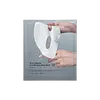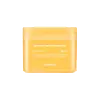What's inside
What's inside
 Key Ingredients
Key Ingredients

 Benefits
Benefits

 Concerns
Concerns

 Ingredients Side-by-side
Ingredients Side-by-side

Water
Skin ConditioningGlycerin
Humectant1,2-Hexanediol
Skin ConditioningCollagen
MoisturisingDipropylene Glycol
HumectantNiacinamide
SmoothingCetyl Ethylhexanoate
EmollientHydroxyacetophenone
AntioxidantCaprylyl Glycol
EmollientDipotassium Glycyrrhizate
HumectantCaprylic/Capric Triglyceride
MaskingChondrus Crispus Powder
AbrasiveCeratonia Siliqua Gum
EmollientBetaine
HumectantChondrus Crispus Extract
Skin ConditioningPotassium Chloride
Sucrose
HumectantGlyceryl Stearate
EmollientPEG-100 Stearate
Panthenol
Skin ConditioningPantolactone
HumectantCellulose Gum
Emulsion StabilisingSodium Polyacrylate
AbsorbentHydrogenated Polydecene
EmollientTrideceth-6
EmulsifyingButyrospermum Parkii Butter
Skin ConditioningPolysorbate 60
EmulsifyingDisodium EDTA
Butylene Glycol
HumectantMentha Rotundifolia Leaf Extract
TonicMentha Viridis Leaf Extract
MaskingMentha Piperita Leaf Extract
Skin ConditioningAdenosine
Skin ConditioningRubus Suavissimus Leaf Extract
Skin ConditioningRose Extract
Skin ConditioningMusa Sapientum Fruit Extract
Skin ConditioningVanilla Planifolia Fruit Extract
Skin ConditioningCrataegus Cuneata Fruit Extract
Skin ConditioningRibes Nigrum Bud Cera
Skin ProtectingXylitylglucoside
HumectantAnhydroxylitol
HumectantXylitol
HumectantGlucose
HumectantPalmitoyl Tripeptide-5
Skin ConditioningGlyceryl Glucoside
HumectantHydrogenated Lecithin
EmulsifyingCetearyl Alcohol
EmollientStearic Acid
CleansingCeramide AP
Skin ConditioningCeramide Ns
Skin ConditioningCeramide NP
Skin ConditioningCeramide EOP
Skin ConditioningCholesterol
EmollientPhytosphingosine
Skin ConditioningPropanediol
SolventBenzyl Glycol
SolventHydrolyzed Glycosaminoglycans
HumectantSodium Hyaluronate Crosspolymer
HumectantHydrolyzed Hyaluronic Acid
HumectantEthylhexylglycerin
Skin ConditioningHydroxypropyltrimonium Hyaluronate
Hyaluronic Acid
HumectantSodium Acetylated Hyaluronate
HumectantPolyglyceryl-10 Laurate
Skin ConditioningTripeptide-1
Skin ConditioningAcetyl Tetrapeptide-2
Skin ConditioningAcetyl Tetrapeptide-5
HumectantCopper Tripeptide-1
Skin ConditioningPalmitoyl Tripeptide-1
Skin ConditioningPalmitoyl Pentapeptide-4
Skin ConditioningHexapeptide-11
Skin ConditioningHexapeptide-9
Skin ConditioningWater, Glycerin, 1,2-Hexanediol, Collagen, Dipropylene Glycol, Niacinamide, Cetyl Ethylhexanoate, Hydroxyacetophenone, Caprylyl Glycol, Dipotassium Glycyrrhizate, Caprylic/Capric Triglyceride, Chondrus Crispus Powder, Ceratonia Siliqua Gum, Betaine, Chondrus Crispus Extract, Potassium Chloride, Sucrose, Glyceryl Stearate, PEG-100 Stearate, Panthenol, Pantolactone, Cellulose Gum, Sodium Polyacrylate, Hydrogenated Polydecene, Trideceth-6, Butyrospermum Parkii Butter, Polysorbate 60, Disodium EDTA, Butylene Glycol, Mentha Rotundifolia Leaf Extract, Mentha Viridis Leaf Extract, Mentha Piperita Leaf Extract, Adenosine, Rubus Suavissimus Leaf Extract, Rose Extract, Musa Sapientum Fruit Extract, Vanilla Planifolia Fruit Extract, Crataegus Cuneata Fruit Extract, Ribes Nigrum Bud Cera, Xylitylglucoside, Anhydroxylitol, Xylitol, Glucose, Palmitoyl Tripeptide-5, Glyceryl Glucoside, Hydrogenated Lecithin, Cetearyl Alcohol, Stearic Acid, Ceramide AP, Ceramide Ns, Ceramide NP, Ceramide EOP, Cholesterol, Phytosphingosine, Propanediol, Benzyl Glycol, Hydrolyzed Glycosaminoglycans, Sodium Hyaluronate Crosspolymer, Hydrolyzed Hyaluronic Acid, Ethylhexylglycerin, Hydroxypropyltrimonium Hyaluronate, Hyaluronic Acid, Sodium Acetylated Hyaluronate, Polyglyceryl-10 Laurate, Tripeptide-1, Acetyl Tetrapeptide-2, Acetyl Tetrapeptide-5, Copper Tripeptide-1, Palmitoyl Tripeptide-1, Palmitoyl Pentapeptide-4, Hexapeptide-11, Hexapeptide-9
Water
Skin ConditioningDipropylene Glycol
HumectantNiacinamide
SmoothingGlycereth-26
Humectant1,2-Hexanediol
Skin ConditioningHippophae Rhamnoides Water
MaskingHydroxyacetophenone
AntioxidantBetaine
HumectantOctyldodeceth-16
EmulsifyingHydroxyethyl Urea
HumectantAllantoin
Skin ConditioningDipotassium Glycyrrhizate
HumectantTrehalose
HumectantXanthan Gum
EmulsifyingHydroxyethylcellulose
Emulsion StabilisingPolyglyceryl-10 Laurate
Skin ConditioningDisodium EDTA
Olea Europaea Fruit Oil
MaskingHydrogenated Lecithin
EmulsifyingPelargonium Graveolens Flower Oil
MaskingLavandula Angustifolia Oil
MaskingAnthemis Nobilis Flower Oil
MaskingCitrus Aurantium Dulcis Peel Oil
MaskingJuniperus Mexicana Oil
MaskingRiboflavin
Cosmetic ColorantSodium Ascorbyl Phosphate
AntioxidantPyridoxine Hcl
Skin ConditioningRetinol
Skin ConditioningTocopheryl Acetate
AntioxidantMenadione
MaskingThiamine Hcl
MaskingCitronellol
PerfumingLinalool
PerfumingGeraniol
PerfumingLimonene
PerfumingWater, Dipropylene Glycol, Niacinamide, Glycereth-26, 1,2-Hexanediol, Hippophae Rhamnoides Water, Hydroxyacetophenone, Betaine, Octyldodeceth-16, Hydroxyethyl Urea, Allantoin, Dipotassium Glycyrrhizate, Trehalose, Xanthan Gum, Hydroxyethylcellulose, Polyglyceryl-10 Laurate, Disodium EDTA, Olea Europaea Fruit Oil, Hydrogenated Lecithin, Pelargonium Graveolens Flower Oil, Lavandula Angustifolia Oil, Anthemis Nobilis Flower Oil, Citrus Aurantium Dulcis Peel Oil, Juniperus Mexicana Oil, Riboflavin, Sodium Ascorbyl Phosphate, Pyridoxine Hcl, Retinol, Tocopheryl Acetate, Menadione, Thiamine Hcl, Citronellol, Linalool, Geraniol, Limonene
 Reviews
Reviews

Ingredients Explained
These ingredients are found in both products.
Ingredients higher up in an ingredient list are typically present in a larger amount.
1,2-Hexanediol is a synthetic liquid and another multi-functional powerhouse.
It is a:
- Humectant, drawing moisture into the skin
- Emollient, helping to soften skin
- Solvent, dispersing and stabilizing formulas
- Preservative booster, enhancing the antimicrobial activity of other preservatives
Betaine is a common humectant (a substance that promotes retention of moisture). It's known to be gentle on the skin and can help balance hydration.
This ingredient is best for improving hydration and soothing irritated skin. Studies also show it helps even out skin tone.
Fun fact: Betaine is naturally created in the skin and body. The kind found within cosmetic products can be either plant-derived or synthetic.
Another name for betaine is trimethylglycine.
Learn more about BetaineDipotassium Glycyrrhizate comes from licorice root.
Extracts of licorice have demonstrated to have antibacterial, anti‐inflammatory, antiviral, antioxidant properties.
One component, glabridin, has extra potent antioxidant and soothing properties. It has also been found to block pigmentation from UVB rays in guinea pigs.
Licorice Root also contains a flavonoid. Flavonoids are a natural substance from in plants. Flavonoids also have antioxidant properties.
Another component, glycyrrhizin, has been found to have anti-inflammatory and antimicrobial benefits. This may make licorice root extract effective at treating acne. However, more research is needed to support this.
Liquiritin is one of the flavone compounds found in licorice. It has been found to help lighten skin by preventing tyrosinase from reacting with tyrosine. When the two react, protein is converted to melanin. Melanin is the substance in your body that gives your features pigmentation.
Licorice root is native to Southern Europe and Asia. It has been used in traditional Chinese medicine to help with respiratory issues.
Learn more about Dipotassium GlycyrrhizateDipropylene Glycol is a synthetically created humectant, stabilizer, and solvent.
This ingredient helps:
Dipropylene glycol is technically an alcohol, but it belongs to the glycol family (often considered part of the ‘good’ alcohols). This means it is hydrating and gentle on skin unlike drying solvent alcohols like denatured alcohol.
As a masking agent, Dipropylene Glycol can be used to cover the smell of other ingredients. However, it does not have a scent.
Studies show Dipropylene Glycol is considered safe to use in skincare.
Learn more about Dipropylene GlycolDisodium EDTA plays a role in making products more stable by aiding other preservatives.
It is a chelating agent, meaning it neutralizes metal ions that may be found in a product.
Disodium EDTA is a salt of edetic acid and is found to be safe in cosmetic ingredients.
Learn more about Disodium EDTAHydrogenated Lecithin is created from the hydrogenation of lecithin (a group of phospholipids). Hydrogenation is a chemical reaction between hydrogen and another element.
This ingredient is an emollient and emulsifier. As an emollient, it helps soften skin by trapping moisture within. As an emulsifier, it prevents oil and water ingredients from separating.
Hydroxyacetophenone is antioxidant with skin conditioning and soothing properties. It also boosts the efficiency of preservatives.
This ingredient is not irritating or sensitizing.
Niacinamide is a multitasking form of vitamin B3 that strengthens the skin barrier, reduces pores and dark spots, regulates oil, and improves signs of aging.
And the best part? It's gentle and well-tolerated by most skin types, including sensitive and reactive skin.
You might have heard of "niacin flush", or the reddening of skin that causes itchiness. Niacinamide has not been found to cause this.
In very rare cases, some individuals may not be able to tolerate niacinamide at all or experience an allergic reaction to it.
If you are experiencing flaking, irritation, and dryness with this ingredient, be sure to double check all your products as this ingredient can be found in all categories of skincare.
When incorporating niacinamide into your routine, look out for concentration amounts. Typically, 5% niacinamide provides benefits such as fading dark spots. However, if you have sensitive skin, it is better to begin with a smaller concentration.
When you apply niacinamide to your skin, your body converts it into nicotinamide adenine dinucleotide (NAD). NAD is an essential coenzyme that is already found in your cells as "fuel" and powers countless biological processes.
In your skin, NAD helps repair cell damage, produce new healthy cells, support collagen production, strengthen the skin barrier, and fight environmental stressors (like UV and pollution).
Our natural NAD levels start to decline with age, leading to slower skin repair, visible aging, and a weaker skin barrier. By providing your skin niacinamide, you're recharging your skin's NAD levels. This leads to stronger, healthier, and younger looking skin.
Another name for vitamin B3 is nicotinamide. This vitamin is water-soluble and our bodies don't store it. We obtain Vitamin B3 from either food or skincare. Meat, fish, wheat, yeast, and leafy greens contain vitamin B3.
The type of niacinamide used in skincare is synthetically created.
Learn more about NiacinamidePolyglyceryl-10 Laurate is an ester of lauric acid and Polyglycerin-10.
Polyglyceryl-10 Laurate is a cleansing agent and emulsifier. It helps gather dirt, oil, and other pollutants to be rinsed away. As an emulsifier, it helps prevent ingredients from separating, such as oil and water.
Polyglyceryl-10 Laurate may not be fungal acne safe.
Learn more about Polyglyceryl-10 LaurateWater. It's the most common cosmetic ingredient of all. You'll usually see it at the top of ingredient lists, meaning that it makes up the largest part of the product.
So why is it so popular? Water most often acts as a solvent - this means that it helps dissolve other ingredients into the formulation.
You'll also recognize water as that liquid we all need to stay alive. If you see this, drink a glass of water. Stay hydrated!
Learn more about Water